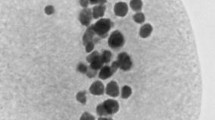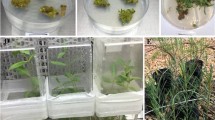Summary
Twenty four B genome aneuploid lines (di-telosomics, nullisomic-tetrasomics and tetrasomics) of Triticum aestivum cv ‘Chinese Spring’ were used in an analysis of the culture ability and regeneration capability of scutellar calli. Several correlations were found between the presence or absence of specific chromosomes and chromosomal arms of the B genome of common wheat and the growth and differentiation capabilities of these calli. The rate of callus growth decreased only when the long arm of chromosome 6B was not present. The absence of chromosomes 3B and 7B did not result in an apparent change in morphogenetic capability, while the absence of other B genome chromosomes was significantly correlated to changes in the frequency of calli that regenerated plants. The presence of the short arm of chromosome 1B was negatively correlated with regeneration, whereas its long arm is probably required to counteract this effect and to maintain the normal ratio of regeneration. The presence of the chromosomal arm 2BS seemed to be essential for differentiation to shoots. In the absence of the short arms of chromosomes 4B and 5B, the rate of regeneration was slightly reduced. In the absence of the long arm of chromosome 6B there was a marked reduction of the ability of scutellar calli to regenerate plants. The use of additional aneuploid lines belonging to homoeologous group 6 revealed that only calli derived from lines having chromosome 6D in their complement regenerated plants similarly to the euploid control. Culture ability and regeneration capability were also analysed with alloplasmic lines of T. aestivum cv ‘Chris’. The lines were derived from five species, representing plasma-types of different phylogenetic distances from plasma-type B of T. aestivum. The results showed that when the endogenous cytoplasm (B-type) was exchanged with T. timopheevii cytoplasm (G-type) there was a significant increase in the regeneration of shoots from the scutellar calli.
Similar content being viewed by others
References
Baroncelli S, Buiatti M, Bennici A, Foroughi-Wehr G, Mix B, Gaul H, Tagliasacchi AM, Loiero M, Giorgi B (1978) Genetic control of in vitro and in vivo growth in hexaploid wheat. 1. Behaviour of ditelosomic lines. Z Pflanzenzücht 80:109–116
Beckert M, Qing CM (1984) Results of a diallel trial and breeding experiment for in vitro aptitude in maize. Theor Appl Genet 68:247–251
Binding H (1974) Cell cluster formation by leaf protoplasts from axenic culture of haploid Petunia hybrida L. Plant Sci Lett 2:185–188
Bingham ET, Hurley LV, Kaatz DN, Saunders JW (1975) Breeding alfalfa which regenerates from callus tissue in culture. Crop Sci 15:719–721
Bullock WP, Baenziger PS, Schaeffer GW, Bottino PJ (1982) Anther culture of wheat (Triticum aestivum L.). F1's and their reciprocal crosses. Theor Appl Genet 62:155–159
Charmet G, Bernard S (1984) Diallel analysis of androgenetic plant production in hexaploid Triticale (X triticosecale, Wittmack). Theor Appl Genet 69:55–61
Cheng TY, Smith HH (1973) The influence of genomes on autonomous growth of pith cultures of Nicotoana glaucalangsdorffii hybrids. Planta 113:29–34
Foroughi-Wehr B, Friedt W, Wenzel G (1982) On the genetic improvement of androgenetic haploid formation in Hordeum vulgare L. Theor Appl Genet 62:233–239
Frankenberger EA, Hasegawa PM, Tigchelaar EC (1981) Diallel analysis of shoot-forming capacity among selected tomato genotypes. Z Pflanzenphysiol 102:233–242
Gosch-Wackerle G, Avivi L, Galun E (1979) Induction, culture and differentiation of callus from immature rahcises, seeds and embryos of Triticum. Z Pflanzenphysiol 91:267–278
Henry Y, de Buyser J (1985) Effect of the 1B/1R translocation on anther culture ability in wheat (Triticum aestivum L.). Plant Cell Rep 4:307–310
Kao KN, Michalyuk MR (1975) Nutritional requirements for growth of Vicia hajastana cells and protoplasts at very low density in liquid media. Planta 126:105–110
Keyes GJ, Collins GB, Taylor NL (1980) Genetic variation in tissue cultures of Red Clover. Theor Appl Genet 58:265–271
Kinohsita T, Mikami T (1984) Alloplasmic effects on callus proliferation and streptomycin resistance in common wheat. Seiken Jiho 32:31–38
Lazar MD, Baenziger PS, Schaeffer GW (1984) Combining abilities and heritability in wheat (Triticum aestivum L.) anther cultures. Theor Appl Genet 68:131–134
Maan SS (1979) Specificity of nucleo-cytoplasmic interactions in Triticum and Aegilops species (a review). Wheat Inf Serv 50:71–79
Maddock SE, Lanchester VA, Risiot R, Franklin J (1983) Plant regeneration from immature embryos and inflorescences of 25 cultivars of wheat (Triticum aestivum). Exp Bot 34:915–926
Mathias RJ, Fukui K (1986) The effect of specific chromosome and cytoplasm substitutions on the tissue culture response of wheat (Triticum aestivum) callus. Theor Appl Genet 71:797–800
Mathias RJ, Fukui K, Law CN (1986) Cytoplasmic effects on the tissue culture response of wheat (Triticum aestivum) callus. Theor Appl Genet 72:70–75
Miah MAA, Earle ED, Khush GS (1985) Inheritance of callus formation ability in anther cultures of rice, Oryza sativa L. Theor Appl Genet 70:113–116
Mitchell AZ, Hanson MR, Skvirsky RC, Ausubel FM (1980) Anther culture of Petunia: genotypes with high frequency of callus, root or plantlet formation. Z Pflanzenphysiol 100:131–146
Nakamura C, Keller WA, Fedak G (1981) In vitro propagation and chromosome doubling of a Triticum crassum x Hordeum vulgare intergeneric hybrid. Theor Appl Genet 60:89–96
Ogura H, Tsuji S (1977) Differential responses of Nicotiana tabacum L. and its putative progenitors to deand redifferentiation. Z Pflanzenphysiol 83:419–426
Orton TJ (1979) A quantitative analysis of growth and regeneration from tissue cultures of Hordeum vulgare, H. jubatum and their interspecific hybrid. Environ Exp Bot 19:319–335
Picard E, de Buyser J, Henry Y (1978) Technique de production d'haploid de ble par culture d'antheres in vitro. Selectionneur Fr 26:25–37
Rauqin C (1982) Genetic control of embryo production and embryo quality in anther culture of Petunia. Theor Appl Genet 63:151–154
Sears ER (1954) The aneuploids of common wheat. Mo Agric Exp Stn Res Bull 572:1–58
Sears RG, Deckard EL (1982) Tissue culture variability in wheat: callus induction and plant regeneration. Crop Sci 22:546–550
Shimada T (1978) Plant regeneration from callus induced from wheat embryo. Jpn J Genet 53:371–374
Shimada T, Makino T (1975) In vitro culture of wheat: 3. Anther culture of the A genome aneuploids in common wheat. Theor Appl Genet 46:407–410
Tomes DT, Smith OS (1985) The effect of parental genotype on initiation of embryogenic callus from elite maize (Zea mays L.) germplasm. Theor Appl Genet 70:505–509
Author information
Authors and Affiliations
Additional information
Communicated by R. Riley
Rights and permissions
About this article
Cite this article
Felsenburg, T., Feldman, M. & Galun, E. Aneuploid and alloplasmic lines as tools for the study of nuclear and cytoplasmic control of culture ability and regeneration of scutellar calli from common wheat. Theoret. Appl. Genetics 74, 802–810 (1987). https://doi.org/10.1007/BF00247560
Received:
Accepted:
Issue Date:
DOI: https://doi.org/10.1007/BF00247560




